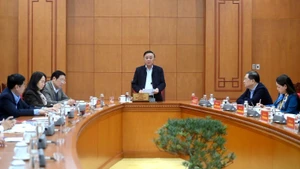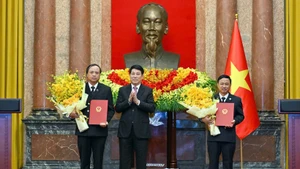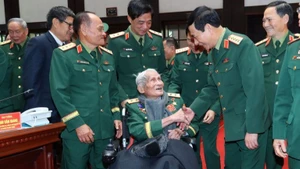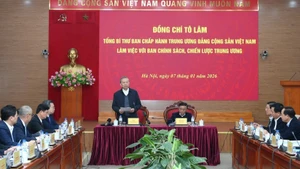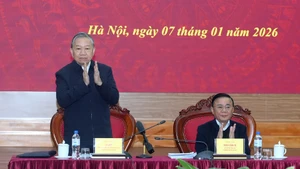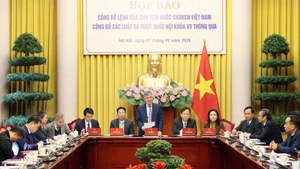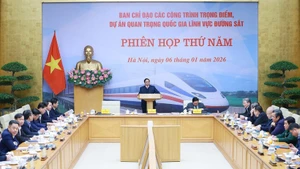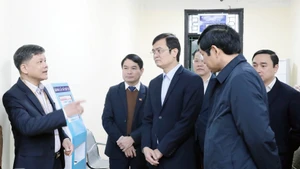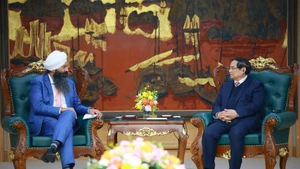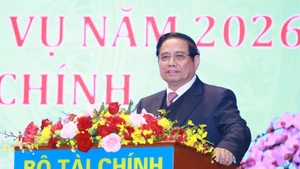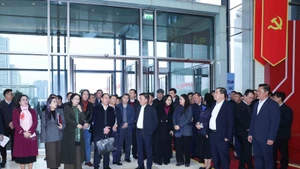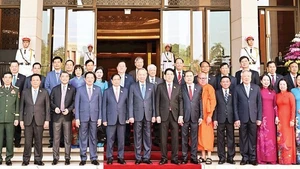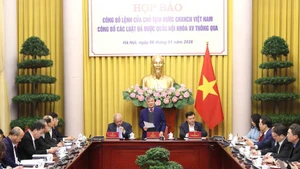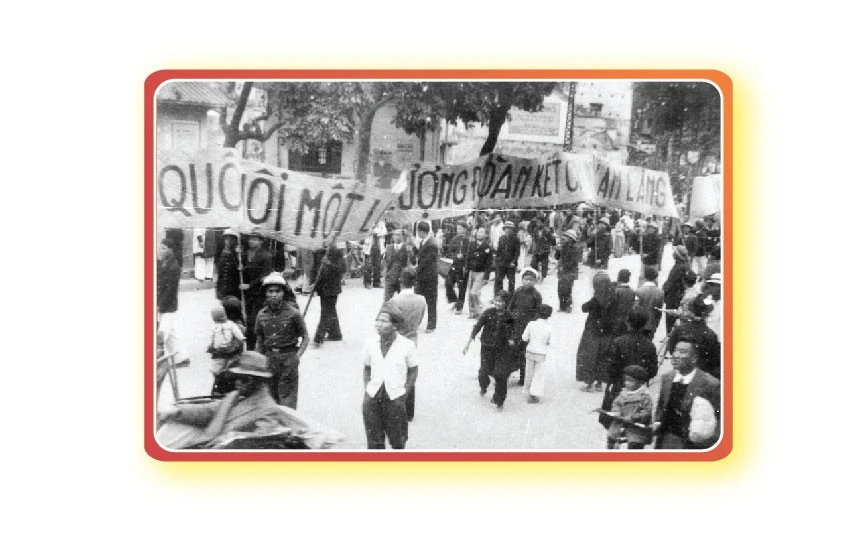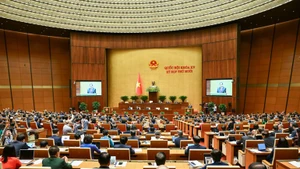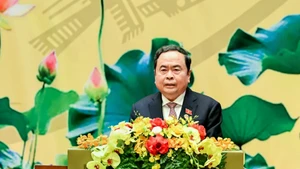An “one-stop, multi-service” model
Concerns about potential overload and delays in processing administrative procedures at newly established commune and ward authorities in densely populated urban areas have been addressed through the flexible and effective measures adopted by the grassroots authorities to meet local practical demands.
Since July 1, the Tan Son Nhat Ward Public Administrative Service Centre (in Ho Chi Minh City) has deployed 10 staff to handle professional tasks and process administrative documents for citizens. The centre has also strengthened its support personnel to assist with document checks, form provision, procedural guidance and directing citizens to the correct working areas. To best accommodate the public, the ward has adopted a “one-stop, multi-service” model.
Alongside the working area of the ward police — who are tasked with residence-related procedures, national population database matters, and security reports — the centre also houses branches of Sub-tax Office No. 16 and Social Insurance Office II to jointly handle inter-agency procedures in a single visit.
According to Nguyen Thanh Danh, Vice Chairman of Tan Son Nhat Ward People's Committee, the new authority apparatus has been operating in a stable manner, ensuring the best service for both the public and businesses. In addition to swiftly resolving administrative procedures, the ward also guarantees the continuity of cultural and social activities, and public order.
Nguyen Trong Dai, Vice Chairman of the People's Committee and Director of the Le Chan Ward Public Administration Centre (in Hai Phong City), said that as the most populous ward in the city, with over 161,000 residents, his ward meticulously and systematically prepared its human resources and facilities for immediate operation on July 1. As a result, there were no long waits or chaotic scenes on the first days of operation. Civil service discipline is strictly enforced at the centre.
During the first four days of operation (July 1–4), the centre received 2,136 visitors, processed 1,167 out of 1,452 applications, and provided guidance for more than 680 others.
Tran Bien Ward, with more than 197,000 residents, has the largest population in Dong Nai Province. Therefore, the ward’s public service centre is consistently busy, particularly with land-related procedures. The ward has expanded its reception area, streamlined procedures, and arranged staff to best support citizens. After one week of operation, the administrative processing has largely run in a smooth manner.
Ho Van Nam, Member of the Dong Nai Provincial Party Standing Committee and Secretary of the Party Committee of Tran Bien Ward, noted that the province now implements inter-connected online services without geographic restriction. Citizens can access services at the nearest public service centre. As many remain unaware of this, the ward is enhancing communication so residents can conveniently access services at nearby locations.
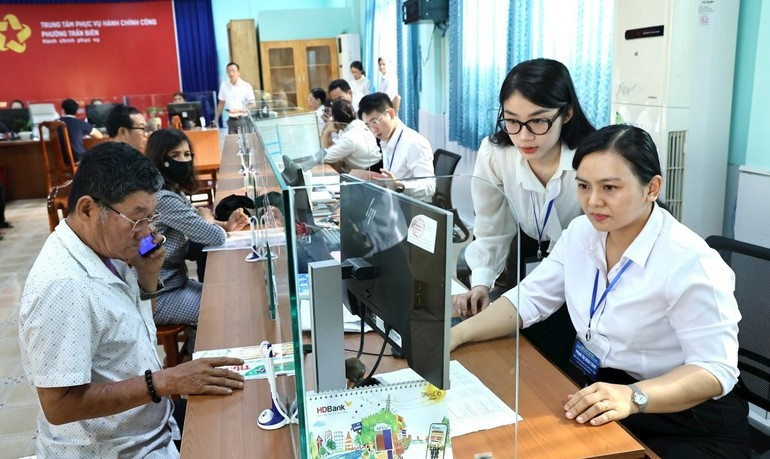
According to the initial assessment by the Dong Nai People’s Committee, after one week of operation, the 95 commune-and-ward-level public service centres have generally met the needs of the public and enterprises. Most citizens have responded positively to the changes brought about by the new model.
In remote and mountainous areas, the first week of implementation saw challenges related to infrastructure and staffing. However, local Party committees and authorities have proactively resolved issues to ensure the smooth processing of administrative procedures.
In some communes and wards in Son La Province, system crashes due to data overload caused delays in handling applications. However, the issue was quickly resolved, and systems resumed stable operation.
Nguyen Minh Tuan, Secretary of the Ngoc Chien Communal Party Committee, said that upon launch, the commune promptly held meetings to assign responsibilities. Each work group was given clear tasks suited to each officer’s expertise. In the first week, over 20 administrative requests were received and processed, earning public satisfaction.
In five mountainous communes of Hue City — A Luoi 1 through A Luoi 5 — many citizens came to carry out administrative procedures and all were guided, received, and assisted in a timely manner. However, as these communes still lack upgraded internet infrastructure and face procedural technical issues, there were moments of service disruption. To address this, the communes upgraded internal networks and internet connections, organised hands-on training for staff, and invested in additional equipment.
In newly formed communes and wards such as Phong Dinh, Kim Tra, Long Quang, and Kim Long, initial technical infrastructure remained limited — data has not been synchronised, and the automatic result-return system had yet to be activated. Hue City coordinated with technical providers such as VNPT, Viettel, and 166 public postal service units.
Ho Don, Chairman of the People’s Committee of Phong Dien Ward, shared: “We established two additional administrative reception points at the former offices of Phong My Commune and Phong Xuan Commune, with files transferred to the new ward office for processing. A contract with VNPT ensures four daily courier cycles so citizens can receive their results on the same day.”
Enhancing proactivity at grassroots level
The implementation of the two-tier local administrative model is not merely a matter of administrative restructuring but creates opportunities for grassroots authorities to exercise greater initiative and flexibility in governance and public service delivery. In reality, many communes and wards have immediately taken on new tasks, especially in areas such as investment, land management, and site clearance.
After establishing 126 new communes and wards, the Ha Noi People’s Committee approved the creation of 126 project management boards under the commune- and ward-level People’s Committees to oversee compensation, support, and resettlement; manage, develop, and exploit land funds; receive land-use rights transfers; and organise land-use rights auctions.
Dang Thi Huyen, Secretary of the Phu Dong Communal Party Committee, stated that the commune is resolutely advancing land clearance, particularly for key projects such as the Gia Binh Airport connecting road, the Lao Cai–Ha Noi–Hai Phong railway, and Duong Bridge, while accelerating the disbursement of public investment capital.
The Phu Xuyen Communal People’s Committee reported that upon activation of the new authority apparatus on July 1, the Party committee and people’s committee established two inter-agency working groups comprising the local police and the economic division to inspect residential areas. As a result, authorities documented 15 violations involving encroachment on public and agricultural land for illegal construction, requiring immediate dismantling to restore the original state.
Under the two-tier model, commune-level authorities have been granted greater decentralised powers, taking on many responsibilities formerly assigned to the district level. This enhances autonomy and proactivity at the grassroots level, improving responsiveness to citizens’ needs.
Nguyen Thanh Luat, Vice Chairman and Director of the An Phu Ward Public Service Centre (in Ho Chi Minh City), noted that amid rapid urbanisation, frequent administrative tasks at the centre involve asset legalisation (land, housing), civil registration, addressing unauthorised construction, site clearance, and individual business registration.
Although the post-restructuring administrative apparatus at the grassroots level has quickly settled into order, several challenges have arisen, requiring timely intervention from higher authorities.
Nguyen Van Hoan, Secretary of the Yen Phong Communal Party Committee (in Bac Ninh Province), explained that prior to restructuring, the former Yen Phong District was developing major infrastructure and social projects, including a wastewater treatment plant with a capacity of 10,000 m³/day, a 5,000-seat stadium, a central square, and a number of inter-commune transport links. However, these projects have been temporarily suspended due to administrative restructuring. These are regional-scale projects with large budgets, beyond the means of a single commune. Therefore, Yen Phong Commune earnestly hopes the province will soon authorise the continuation of these projects to serve the people and improve living standards.
While initial difficulties remain, the two-tier local authority model is gradually settling into place, improving service delivery and creating positive changes at the grassroots level. Actual implementation will remain the yardstick by which local authorities can adjust, resolve obstacles, and fine-tune the apparatus to ensure smooth and effective operations, all in service of the people.

